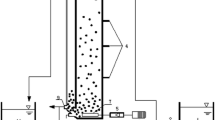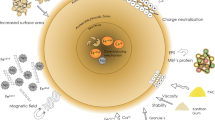Abstract
Granular activated carbon (GAC) has been proved to accelerate the formation of aerobic granules during wastewater treatment. However, there has never been a study on the extracellular polymeric substances (EPS) or structural stability of the GAC aerobic granules. Thus, this study evaluated the impact of GAC on these characteristics. With GAC addition, granules matured 12 days earlier than those of the control group. Scanning electron microscopy showed the surface of aerobic granules enhanced by GAC to be denser and smoother than the surface of control granules, which could be the first line of defense against external selection pressure. After granules matured, there was no difference in contamination removal between the two types of granules. The protein content in EPS of GAC aerobic granules was higher than that of the control group; however, there was no difference in the polysaccharide content. EPS fluorescence in situ staining demonstrated that inside the aerobic granules, a high concentration of protein encapsulated the GAC. In addition, integrity coefficients indicated that GAC significantly improved the ability of aerobic granules to resist hydraulic shear. The result of hydrolase treatment proved that the outer layer structure of the GAC aerobic granules was maintained by β-polysaccharide, and the inner layer structure was maintained by protein. The ability of GAC-enhanced aerobic granules to resist single hydrolase was stronger than that of the control group.







Similar content being viewed by others
References
Adav SS, Lee DJ (2008) Extraction of extracellular polymeric substances from aerobic granule with compact interior structure. J Hazard Mater 154:1120–1126
Basheer F, Isa MH, Farooqi IH (2012) Biodegradation of o-nitrophenol by aerobic granules with glucose as co-substrate. Water Sci Technol 65:2132–2139
Beun JJ, van Loosdrecht MC, Heijnen JJ (2002) Aerobic granulation in a sequencing batch airlift reactor. Water Res 36:702–712
Chen Z, Sun S, Xiang L, Wan C, Lee DJ (2017) Influence of operational conditions on the stability of aerobic granules from the perspective of quorum sensing. Environ Sci Pollut Res Int 24:7640–7649
Eaton AD (1998) Standard methods for the examination of water and wastewater. APHA. In: 113-X pp
Felz S, Al-Zuhairy S, Aarstad OA, van Loosdrecht MCM, Lin YM (2016) Extraction of structural extracellular polymeric substances from aerobic granular sludge. J Vis Exp (115). https://doi.org/10.3791/54534
Ghangrekar MM, Asolekar SR, Ranganathan KR, Joshi SG (1996) Experience with UASB reactor start-up under different operating conditions. Water Sci Technol 34:421–428
Hulshoff Pol LW, Si DCL, Lettinga G, Lens PN (2004) Anaerobic sludge granulation. Water Res 38:1376–1389
Kreuk MKD, Heijnen JJ, Loosdrecht MCMV (2005a) Simultaneous COD, nitrogen, and phosphate removal by aerobic granular sludge. Biotechnol Bioeng 90:761–769
Kreuk MKD, Pronk M, Loosdrecht MCMV (2005b) Formation of aerobic granules and conversion processes in an aerobic granular sludge reactor at moderate and low temperatures. Water Res 39:4476–4484
Lee DJ, Chen YY, Show KY, Whiteley CG, Tay JH (2010) Advances in aerobic granule formation and granule stability in the course of storage and reactor operation. Biotechnol Adv 28:919–934
Li AJ, Li XY, Yu HQ (2011) Granular activated carbon for aerobic sludge granulation in a bioreactor with a low-strength wastewater influent. Sep Purif Technol 80:276–283
Li AJ, Li XY, Yu HQ (2013) Aerobic sludge granulation facilitated by activated carbon for partial nitrification treatment of ammonia-rich wastewater. Chem Eng J 218:253–259
Lin YM, Liu Y, Tay JH (2003) Development and characteristics of phosphorus-accumulating microbial granules in sequencing batch reactors. Appl Microbiol Biotechnol 62:430–435
Liu YQ, Liu Y, Tay JH (2004) The effects of extracellular polymeric substances on the formation and stability of biogranules. Appl Microbiol Biotechnol 65:143–148
Liu YQ, Moy B, Kong YH (2010) Formation, physical characteristics and microbial community structure of aerobic granules in a pilot-scale sequencing batch reactor for real wastewater treatment. Enzym Microb Technol 46:520–525
Liu Z, Liu Y, Kuschk P, Wang J, Chen Y, Wang X (2016) Poly aluminum chloride (PAC) enhanced formation of aerobic granules: coupling process between physicochemical–biochemical effects. Chem Eng J 284:1127–1135
Long B, Yang CZ, Pu WH, Yang JK, Jiang GS, Dan JF, Li CY, Liu FB (2014) Rapid cultivation of aerobic granular sludge in a pilot scale sequencing batch reactor. Bioresour Technol 166:57–63
Luo J, Hao T, Wei L, Mackey HR, Lin Z, Chen GH (2014) Impact of influent COD/N ratio on disintegration of aerobic granular sludge. Water Res 62:127–135
Moy YP, Tay JH, Toh SK, Liu Y, Tay TL (2010) High organic loading influences the physical characteristics of aerobic sludge granules. Lett Appl Microbiol 34:407–412
Nancharaiah YV, Kiran GKR (2018) Aerobic granular sludge technology: mechanisms of granulation and biotechnological applications. Bioresour Technol:247
Reddy GKK, Nancharaiah YV (2018) Sustainable bioreduction of toxic levels of chromate in a denitrifying granular sludge reactor. Environ Sci Pollut Res 25:1–11
Sarma SJ, Tay JH, Chu A (2016) Finding knowledge gaps in aerobic granulation technology. Trends Biotechnol 35:66–78
Seviour T, Pijuan M, Nicholson T, Keller J, Yuan Z (2009) Gel-forming exopolysaccharides explain basic differences between structures of aerobic sludge granules and floccular sludges. Water Res 43:4469–4478
Sheng G, Li A, Li X, Yu H (2010) Effects of seed sludge properties and selective biomass discharge on aerobic sludge granulation. Chem Eng J 160:108–114
Świątczak P, Cydzikkwiatkowska A (2018) Performance and microbial characteristics of biomass in a full-scale aerobic granular sludge wastewater treatment plant. Environ Sci Pollut Res Int 25:1655–1669
Tao J, Qin L, Liu X, Li B, Chen J, You J, Shen Y, Chen X (2017) Effect of granular activated carbon on the aerobic granulation of sludge and its mechanism. Bioresour Technol 236:60–67
Tay JH, Liu QS, Liu Y (2001) The effects of shear force on the formation, structure and metabolism of aerobic granules. Appl Microbiol Biotechnol 57:227–233
Tay JH, Liu QS, Liu Y (2002) Characteristics of aerobic granules grown on glucose and acetate in sequential aerobic sludge blanket reactors. Environ Technol Lett 23:931–936
Thanh BX (2009) Characterization of aerobic granular sludge at various organic loading rates. Process Biochem 44:242–245
Tsuneda S, Aikawa H, Hayashi H, Yuasa A, Hirata A (2010) Extracellular polymeric substances responsible for bacterial adhesion onto solid surface. FEMS Microbiol Lett 223:287–292
Wang Z, Liu L, Yao J, Cai W (2006) Effects of extracellular polymeric substances on aerobic granulation in sequencing batch reactors. Chemosphere 63:1728–1735
Yu G, Lee D, He P, Shao L, Lai J (2010) Fouling layer with fractionated extracellular polymeric substances of activated sludge. Sep Sci Technol 45:993–1002
Zhou JH, Zhao H, Hu M, Yu HT, Xu XY, Vidonish J, Alvarez PJJ, Zhu L (2015) Granular activated carbon as nucleating agent for aerobic sludge granulation: effect of GAC size on velocity field differences (GAC versus flocs) and aggregation behavior. Bioresour Technol 198:358–363
Zhu L, Dai X, Meile X (2013) Correlation analysis of major control factors for the formation and;stabilization of aerobic granule. Environ Sci Pollut Res 20:3165–3175
Zhu L, Zhou J, Lv M, Yu H, Zhao H, Xu X (2015) Specific component comparison of extracellular polymeric substances (EPS) in flocs and granular sludge using EEM and SDS-PAGE. Chemosphere 121:26–32
Acknowledgments
This work was jointly supported by the Natural Science Foundation of China (NSFC 51779020, 51609024, and 51478061) and the National Science and Technology Major Project (2015ZX07319-001).
Author information
Authors and Affiliations
Corresponding author
Ethics declarations
Conflict of interest
The authors declare that they have no conflict of interest.
Additional information
Responsible editor: Philippe Garrigues
Publisher’s Note
Springer Nature remains neutral with regard to jurisdictional claims in published maps and institutional affiliations.
Electronic supplementary material
ESM 1
(DOCX 82 kb)
Rights and permissions
About this article
Cite this article
Liang, Z., Tu, Q., Su, X. et al. Formation, extracellular polymeric substances, and structural stability of aerobic granules enhanced by granular activated carbon. Environ Sci Pollut Res 26, 6123–6132 (2019). https://doi.org/10.1007/s11356-018-04101-1
Received:
Accepted:
Published:
Issue Date:
DOI: https://doi.org/10.1007/s11356-018-04101-1




